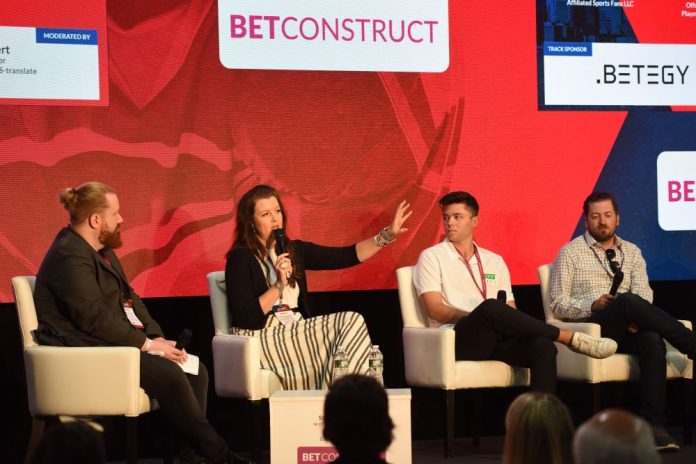We live in a world where social media has become commonplace in our daily lives. But can these platforms, which were once used as a means of staying in touch with friends, form an important part of a brand’s marketing strategy?
Whenever a major sports news story breaks, it is inevitable. You open up Twitter or TikTok and are bombarded with sports betting social media accounts posting memes, fresh odds and the latest big bets and hot picks related to the headline.
Pat McAfee, Dave Portnoy and now Jake Paul draw headlines for bringing sports betting brands to their massive social media audiences.
Measuring social media success in sports betting though is less about who posted first or how many likes a post got, or even how many impressions a post gets. When social media experts within the field of sports betting discuss success, the focus is on brand awareness, community building and, of course, costs per acquisition.
What they also say is that you can’t think of social as just an auxiliary channel or an augmentation of your product’s marketing campaign.
Sisca Concannon is currently the Co-Founder and Chief Marketing Officer of Affiliated Sports Fans. Prior to that, she spent almost two years as Vice President of Marketing at Penn Interactive, overseeing the launch and growth of the Barstool Sportsbook brand. Speaking at SBC Summit North America earlier this year, Concannon cautioned marketers about treating social media as an afterthought.
“This is part of your relationship marketing strategy,” she explained. “If you see it purely as a way to put up your ads for your risk-free bet to sign up and that’s it, then you’re missing the mark. You don’t know who your personality is as a brand.
“Know who you are as a personality and double down the relationship marketing aspect. Yes, sign up, but you’re not just signing up to get my risk-free bet, you’re signing up for a lot more value add. What is your value add? And I think once you understand building loyalty and building a relationship with your audience, that’s the strength of social. It’s not about ads. It’s about developing a content marketing strategy that engages and builds a relationship and loyalty.”
A major part of this relationship building is the less glamorous world of customer service. In order to appeal to the generation of sports fans living on social, you have to be able to address their problems on socials.
“You’ll find, if you do not have a social customer service strategy, unfortunately, you’re not going to be in the mix in five years time. It’s a critical, critical part of your social strategy to extend your customer service into a social platform,” Concannon said.
Being able to swiftly discover and solve customer issues on social both helps retention and fosters a sense of community. It is certainly not the only way to do so. In fact, community building often requires more resources than people realise.
Troy Paul, Founder and CEO of Sports Gambling Guides, an affiliate group focused on social media, works extensively at building followings with thousands of influencers. Speaking on the same panel, he warned that if you can’t walk the tightrope of commerce and community, it is often a problem you can’t come back from.
He said: “It’s extremely important as you’re building a social media channel that you’re focused on what your demographic is looking for. What is your niche looking to find? What type of content are they looking to see, and focus primarily on that.
“It’s really finding this balancing act because you do want to get your ads out there, you do want to drive your customers to whatever your product is, but it’s finding that fine line of not doing it too much to the point where you start to alienate your following. Because once you do that, then whatever channel that is, it’s really hard to bring it back.”
Defining your niche in sports betting social media is something many operators and influencers alike are struggling with. Everyone on the SBC Summit North America panel seemed to agree that part of the problem is that the actual sports betting products in the US are not materially different. There are a few different markets and the colour schemes vary. Nonetheless they are all going after the same audience with mostly the same offering.
VP of US Marketing for 888 Holdings Noam Klivitzky knows he can’t compete that way.
“Just repeating the news all the time in your social feed is not going to create any differentiation to any brand. Because these are exactly the kinds of things customers can acquire in 10 other places, so there is no reason they won’t do that on social media,” he said.
“One of the things we’ve been trying to do is get them a much more unique experience that when they think about it in the future, they will always remember what brand is offering it to them.”
Klivitzky used a campaign SI Sportsbook did where the company’s social channels gave away popular covers of Sports Illustrated magazine. Internal research indicated 60% of sports fans had an SI cover on the wall to begin with. Giving away something so tied to a brand not only engendered goodwill from its customer base, it gave them a means to literally put the brand up on the wall where they would never forget about it.
Working with an established brand like SI is much different to smaller brands or sports betting influencers trying to build a community. One of the most popular ways these brands and personalities aim to gain traction is with touting their picks across social media channels, including TikTok, which currently has a ban on gambling content.
While touting is en vogue, many experts agree this is not a long-term strategy for social relevance. David Woodley, President and Chief Revenue Officer of Playmaker concedes some of these methods may be good for short-term results. For Playmaker’s media arm, those wins are not worth the long-term losses they could create.
“We’ll never do anything that hurts our audience. We’ve built a lot of trust with them over the years, and they are young, and if we give them bad advice, they will not cancel us, but we’ll hear about it and it will make my life awful,” Woodley said.
Playmaker has a no-pick policy and tells its influencers as much from the jump.
“We don’t do any picks and we have a lot of athletes that work for us, so we just say no picks and I think that’s because I think we’re honest with people and we say, ‘you’re taking a pick from anyone, you’re not going to be profitable long-term’,” Woodley added. “And that said, if anyone could actually pick at 60%, they wouldn’t be frickin’ hustling on social media for a $30 Discord or Patreon. Then beyond that, I think if you make a pick, you’re gonna piss off your audience 50% of the time.”
Concannon has seen picks work for groups like Barstool, but with a caveat. You have to create unique content around the pick, not just throw out a number with a meme and post it.
“You can develop incredible content around picks that doesn’t have to be the stale kind of ‘these are my picks for the week’,” she explained.
Social media is fast-paced, but in order to succeed over time, it is a long process and one that involves so much more than being first with a meme. You have to build a brand while building community, entertain while providing service, and companies and influencers have to think beyond what is working now to build a brand that will work for years to come.














